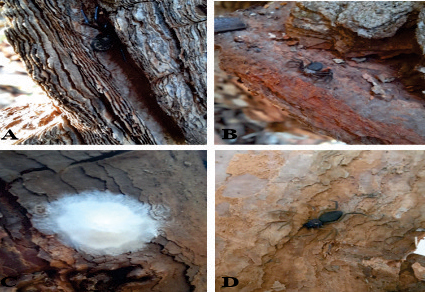Abstract
Spiders of the family Trochanteriidae are characterized by the carapace being extremely flat, with a reflex border, medium posterior eyes flattened, laterigrade legs, the absence of claw tufts, anterior lateral spinnerets with an incomplete distal article, and an inflatable and epiginal plate formed by a divided plate. Two out of the six worldwide genera of Trocantheriids have species in the Brazilian areas: Trochanteria Karsch and Vectius Simon. Here we present the redescription of Vectius niger and morphological data of Trochanteria gomezi, with an expansion of the distribution of these species in the Neotropical region and unpublished chromosomal data of both species. Mitotic and meiotic cells of both T. gomezi and V. niger showed 2n♂=22 and 2n♀=24 telocentric chromosomes, with a sex chromosome system of the type X1X2 in males/X1X1X2X2 in females. The chromosomal data shown here matches those found in trochanteriids to date.
References
- Araujo, D., Rheims, C.A., Brescovit, A.D. & Cella, D.M. (2008) Extreme degree of chromosome number variability in species of the spider genus Scytodes (Araneae, Haplogynae, Scytodidae). Journal of Zoological Systematics and Evolutionary Research, 46, 89–95. https://doi.org/10.1111/j.1439-0469.2007.00457.x
- Araujo, D., Schneider, M.C., Paula-Neto, E. & Cella, D.M. (2023) The spider cytogenetic database. Available from: https://arthropodacytogenetics.bio.br/spiderdatabase/ (accessed 21 August 2023)
- Azevedo, G.H.F, Griswold, C.E. & Santos, A.J. (2018) Systematics and evolution of ground spiders revisited (Araneae, Dionycha, Gnaphosidae). Cladistics, 34 (6), 579−626. https://doi.org/10.1111/cla.12226
- Azevedo, G.H.F., Bougie, T., Carboni, M., Hedin, M. & Ramírez, M.J. (2022) Combining genomic, phenotypic and Sanger sequencing data to elucidate the phylogeny of the two-clawed spiders (Dionycha). Molecular Phylogenetics and Evolution, 166, 107327. https://doi.org/10.1016/j.ympev.2021.107327
- Canals, J. (1933) Curiosa araña argentina del genero Trochanteria Karsch. Physis, 11, 233−237.
- Carvalho, L.S., Brescovit, A.D., Santos, A.J., Oliveira, U. & Guadanucci, J.P. (2014) Aranhas da Caatinga. In: Bravo, F. & Calor, A. (Eds.), Artrópodes do semi-árido Biodiversidade e Conservação. Print Mídia, Feira de Santana, pp. 15−32.
- Carvalho, L.S., Martins, P.H., Schneider, M.C. & Cabra-Garcia, J.J. (2017) New records of spiders (Arachnida, Araneae) from the state of Roraima, northern Brazil. Check List, 13, 2040. https://doi.org/10.15560/13.1.2040
- Carvalho, L.S., Oliveira, B.B., Dias, D.F., Silva, I.S.S., Soares J.F., Silva, M.I.L., Santos, T.C., Silva, P.R.R. & Paranhos, J.D.N. (2020) Biodiversidade e Conservação dos Aracnídeos do Parque Nacional da Serra das Confusões, Sul do Piauí. In: Ivanov M.M.M. (Ed.), Unidades de Conservação do Estado do Piauí. EDUFPI, Teresina, pp. 1–429.
- Corronca, J.A. (1996) Catálogo de las especies de la familia Selenopidae Simon, 1887 (Araneae). Acta Zoologica Lilloana, 43, 393−409.
- QGIS (2023) Geospatial Foundation Project. Available from: http://qgis.osgeo.org (accessed 24 October 2023)
- Mello-Leitão, C.F. (1915) Alguns gêneros e espécies novas de araneidos do Brasil. Brotéria, Série Zoológica, 13, 129−142.
- Mello-Leitão, C.F. (1942) Arañas del Chaco y Santiago del Estero. Revista del Museo de La Plata, Nueva Serie, Zoología, 2, 381−426.
- Moreira, T. da S., Baptista, R.L.C., Kury, A.B., Giupponi, A.P.L., Buckup, E.H. & Brescovit, A.D. (2010) Annotated check list of Arachnida type specimens deposited in the Museu Nacional, Rio de Janeiro. II—Araneae. Zootaxa, 2588 (1), 1−91. https://doi.org/10.11646/zootaxa.2588.1.1
- Platnick, N.I. (1986) A revision of the spider genus Trochanteria (Araneae: Gnaphosoidea). Bulletin of the British Arachnological Society, 7, 29−33.
- Platnick, N.I. (1990) Spinneret morphology and the phylogeny of ground spiders (Araneae, Gnaphosoidea). American Museum Novitates, 2978, 1−42.
- Roewer, C.F. (1955) Katalog der Araneae von 1758 bis 1940, bzw. 1954. 2. Band, Abt. a (Lycosaeformia, Dionycha [excl. Salticiformia]). 2. Band. Abt. B (Salticiformia, Cribellata) (Synonyma—Verzeichnis, Gesamtindex). Institut royal des Sciences naturelles de Belgique Bruxelles, 1751 pp.
- Simon, E. (1880) Révision de la famille des Sparassidae (Arachnides). Actes de la Société Linnéenne de Bordeaux, 34 (2/3/4), 223−351. https://doi.org/10.2979/RAL.2003.34.2.223
- Simon, E. (1897) Histoire naturelle des araignées. Deuxième édition, tome second. Roret, Paris, 192 pp.
- Srivastava, M.D.L. & Shukla, S. (1986) Chromosome number and sex-determining mechanism in forty-seven species of Indian spiders. Chromosome Information Service, 41, 23−26.
- Št`áhlavský, F., Forman, M., Just, P., Denič, F., Haddad, C.R. & Opatová, V. (2020) Cytogenetics of entelegyne spiders (Arachnida, Araneae) from southern Africa. Comparative Cytogenetics, 14 (1), 107−138. https://doi.org/10.3897/CompCytogen.v14i1.48667
- World Spider Catalog (2023) World Spider Catalog. Version 24. Natural History Museum Bern, Bern. Available from: http://wsc.nmbe.ch (accessed 28 February 2023)


